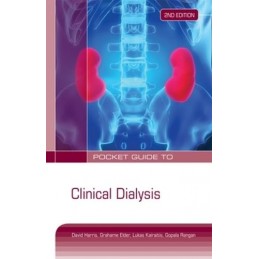- Reduced price

Order to parcel locker

easy pay


 Delivery policy
Delivery policy
Choose Paczkomat Inpost, Orlen Paczka, DHL, DPD or Poczta Polska. Click for more details
 Security policy
Security policy
Pay with a quick bank transfer, payment card or cash on delivery. Click for more details
 Return policy
Return policy
If you are a consumer, you can return the goods within 14 days. Click for more details
Pocket Guide to Clinical Dialysis 2/e is an ideal quick-reference guide and provides practical and essential information about haemodialysis, its physiology and equipment used, chronic peritoneal dialysis and acute dialysis. The book has been written by doctors, nurses, pharmacists and dieticians and their colleagues in renal units. This book features practical, easy-to-read information on management protocols currently employed in hospitals, providing step-by-step guidelines for patient care and useful references
Data sheet
About the editors v
About the contributors vi
Preface ix
List of protocols x
List of tables xiv
List of figures xvii
Abbreviations xviii
Part 1 Introduction 1
Chapter 1.1 Normal kidney function 3
Chapter 1.2 Stages of chronic kidney disease 5
Chapter 1.3 Assessment of the patient with chronic kidney disease 8
Chapter 1.4 Limitations of dialysis as replacement fornormal kidney function 18
Chapter 1.5 Early chronic kidney disease and preparation of the patient for maintenance dialysis 20
Chapter 1.6 Conservative therapy for advanced chronickidney disease 29
Part 2 General care of patients with chronickidney disease 37
Chapter 2.1 Chronic kidney disease mineral and bonedisorder 39
Chapter 2.2 Cardiovascular risk and its management 52
Chapter 2.3 Erythropoiesis 61
Chapter 2.4 Bleeding and thrombosis 68
Chapter 2.5 Endocrine disturbances of chronickidney disease 76
Chapter 2.6 Infection control 84
Chapter 2.7 Pregnancy and dialysis 90
Chapter 2.8 Preparation for kidney transplantation 97
Chapter 2.9 Drug prescribing to patients on dialysis 103
Chapter 2.10 Nutrition 108
Chapter 2.11 Routine monitoring of dialysis patients 115
Chapter 2.12 Testing health-related quality of lifeand functional ability 119
Part 3 Haemodialysis 123
Chapter 3.1 Haemodialysis physiology 125
Chapter 3.2 Haemodialysis equipment 132
Chapter 3.3 Haemodialysis adequacy and prescription 137
Chapter 3.4 Vascular access for haemodialysis 148
Chapter 3.5 Anticoagulation for haemodialysis 169
Chapter 3.6 Managing the first haemodialysis treatmentin a patient with end-stage kidney disease 173
Chapter 3.7 Complications during haemodialysis 176
Chapter 3.8 Haemodialysis in children 186
Part 4 Chronic peritoneal dialysis 189
Chapter 4.1 General principles 191
Chapter 4.2 Peritoneal membrane physiology 196
Chapter 4.3 Peritoneal dialysis access and complications 202
Chapter 4.4 Peritoneal dialysis solutions and connection systems 216
Chapter 4.5 Prescribing and assessing the adequacyof peritoneal dialysis 225
Chapter 4.6 Preserving residual renal and peritonealmembrane function 234
Chapter 4.7 Abnormal fluid volume status inchronic peritoneal dialysis 240
Chapter 4.8 Peritonitis and exit-site infections 245
Chapter 4.9 Non-infective complications of chronicperitoneal dialysis 256
Part 5 Acute dialysis 263
Chapter 5.1 Dialysis for acute kidney injury 265
Chapter 5.2 Extracorporeal therapy for acute poisoning 277
Chapter 5.3 Plasmapheresis 283
Index 289
Reference: 12253
Author: Grażyna Cepuch
Reference: 12279
Author: Krzysztof Krzystyniak
